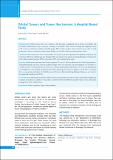Please use this identifier to cite or link to this item:
https://hdl.handle.net/20.500.14356/1001Full metadata record
| DC Field | Value | Language |
|---|---|---|
| dc.contributor.author | Poudyal, Prija | - |
| dc.contributor.author | Hamal, Diwa | - |
| dc.contributor.author | Shrestha, Pawan | - |
| dc.date.accessioned | 2023-04-19T09:19:22Z | - |
| dc.date.available | 2023-04-19T09:19:22Z | - |
| dc.date.issued | 2022 | - |
| dc.identifier.citation | PoudyalP., HamalD., & ShresthaP. (2022). Orbital Tumors and Tumor like Lesions: A Hospital Based Study. Journal of Nepal Health Research Council, 20(01), 26-32. https://doi.org/10.33314/jnhrc.v20i01.3727 | en_US |
| dc.identifier.issn | Print ISSN: 1727-5482; Online ISSN: 1999-6217 | - |
| dc.identifier.uri | http://103.69.126.140:8080/handle/20.500.14356/1001 | - |
| dc.description | Original Article | en_US |
| dc.description.abstract | Abstract Background: Orbital tumors have rare incidence, still they play a significant role in terms of morbidity and mortality. Orbital tumors may be primary, secondary or metastatic. These consist of benign and malignant lesions with extreme variations in pediatric and adult groups. These lesions can have acute or chronic onset, slow to rapid progression with or without bony destructions leading to vision loss, deformity and sometimes death. Methods: This retrospective cross-sectional study was carried out in the Department of Ophthalmic Pathology and Laboratory Medicine in Biratnagar Eye Hospital. Fifty-one patients who underwent histopathological evaluation for their orbital lesions from June 2018 to December 2019 were included in the study. Results: Orbital tumor and tumor like lesions comprised 27 cases (52.94%) in adults and 24 (47.06%) in paediatrics. Histopathologically, the most common pediatric benign tumor was dermoid cyst and malignant was secondary to orbital extension of retinoblastoma. Also, the most common adult benign orbital tumor was cavernous hemangioma and malignant was non Hodgkins lymphoma. The clinico-pathological accuracy for diagnosis was 68.63%. Association between age groups and nature of orbital lesions and between clinical and histopathological diagnosis was found to be statistically significant (p<0.05). Conclusions: Orbital tumors and tumor like lesions are uncommonly encountered. These masses showed significant variation in incidence in children versus adults. Combined efforts by different specialties help in early and prompt management of the orbital tumors. Keywords: Adult; neoplasms; Nepal; orbit; pediatrics. | en_US |
| dc.language.iso | en | en_US |
| dc.publisher | Nepal Health Research Council | en_US |
| dc.relation.ispartofseries | Jan-March, 2022;3727 | - |
| dc.subject | Adult | en_US |
| dc.subject | neoplasms | en_US |
| dc.subject | Nepal | en_US |
| dc.subject | orbit | en_US |
| dc.subject | pediatrics | en_US |
| dc.title | Orbital Tumors and Tumor like Lesions: A Hospital Based Study | en_US |
| dc.type | Journal Article | en_US |
| local.journal.category | Original Article | - |
| Appears in Collections: | Vol. 20 No. 01 (2022): Issue 54 Jan-March, 2022 | |
Files in This Item:
| File | Description | Size | Format | |
|---|---|---|---|---|
| 3727-Manuscript-27863-1-10-20220606.pdf | Fulltext Download | 187.84 kB | Adobe PDF |  View/Open |
Items in DSpace are protected by copyright, with all rights reserved, unless otherwise indicated.
